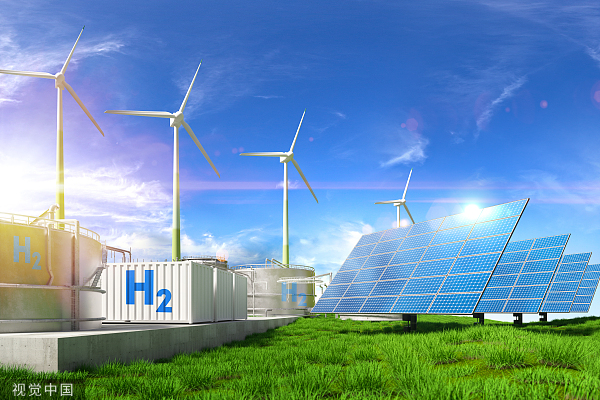
Credit: Visual China
BEIJING, September 6 (AsianFin) – To counter climate change, the Chinese government has set the goal to reach carbon peak by 2030 and achieve carbon neutrality by 2060.
In this pursuit, hydrogen energy is highly regarded due to its abundant reserves, no greenhouse gas emissions during consumption, and long storage time. It is seen as the main force in the fields of industrial decarbonization, long-term energy storage and transportation, and commercial vehicle fuel cells in the future.
The hydrogen energy industry, which has never been commercialized on a large scale before, is also widely regarded as facing a historic opportunity of development.
Recently, there have been many significant events in the hydrogen energy field, both in terms of policies and enterprises, and all parties have clearly accelerated their progress.
Intensive Policies and Plans
As an "emerging force" in the traditional field, hydrogen energy lacks competitive advantages in the initial stage due to high costs and immature technology. Policy support is essential for its development, and the policy-driven effect of China's hydrogen energy industry development is particularly evident.
On March 23, 2022, the National Development and Reform Commission (NDRC) and the National Energy Administration (NEA) jointly issued the Medium and Long-term Plan for the Development of the Hydrogen Energy Industry (2021-2035), which clearly stated that hydrogen energy is part and parcel of the future national energy system and an important carrier for achieving green and low-carbon transformation with energy terminal.
On August 8 of this year, another national-level policy was issued in China. The National Standardization Committee, together with the NDRC, the Ministry of Industry and Information Technology, the Ministry of Ecology and Environment, the Ministry of Emergency Management, and the NEA, jointly issued the construction guidelines for the standards of the hydrogen energy industry chain, which is China's first top-level design guide for the hydrogen energy standard system.
At the provincial government level, Zhejiang, Xinjiang, Guangxi, Ningxia, Jilin, and other places have successively introduced development plans and action plans for the hydrogen energy industry. Among them, Xinjiang has the strongest policy support.
In addition to provincial-level support, more than 20 sub-provincial or prefecture-level cities such as Xi'an, Ordos, Baotou, and Huzhou have also successively released action plans for the development of the hydrogen energy industry from August to September.
The intensive introduction of policies has created the sense of optimism for the industry. According to a research report by China Everbright Securities, the release of a host of policies is conducive to the formation of resonance in the industry, and the development of the hydrogen energy industry is expected to further accelerate.
High Demand for Both Hydrogen Production and Utilization
Besides policies, there was another event in August that excited the industry.
China Petroleum & Chemical Corporation (Sinopec) announced last Wednesday that its Xinjiang Kuqa Green Hydrogen Demonstration Project was completed and put into operation. The electrolytic water hydrogen production capacity is 20,000 tons per year, and it is all supplied to Sinopec Tahe Petrochemical Co., Ltd. in proximity to replace the natural gas used for hydrogen production in oil refining, achieving decarbonization and green development.
This project is the largest direct hydrogen production project of photovoltaic power generation in China, and the first project in the country to achieve large-scale industrial applications of green hydrogen. After the information was released, many media outlets described the project's completion as "a breakthrough" and "industry sensation".
Why can the completion of a project attract so much attention from the industry? There are three main reasons.
First, its milestone scale. The completion of the Kuqa project will rapidly increase the capacity of hydrogen production from renewable sources to the level of 20,000 tons per year. Hydrogen production from renewable sources refers to the direct production of hydrogen through renewable energy sources such as wind, solar, and water. Compared with the mainstream hydrogen production from fossil fuels, that from renewable sources does not generate greenhouse gases during the production process, so the produced hydrogen is called "green hydrogen." Green hydrogen is a clear future focus in China’s national hydrogen energy plan. However, it has been limited by high production costs and unstable power sources, and the production capacity has been unable to increase. In the national plan, the target for renewable energy hydrogen production in 2025 is set at 100,000 to 200,000 tons per year. The Xinjiang action plan sets the target for renewable energy hydrogen production in the whole year of 2023 at more than 20,000 tons per year, which is the same as the annual capacity of the Kuqa project. This shows the significance of the project.
Second, its demonstration effect. Industry decarbonization is the main battlefield for hydrogen energy applications. According to the prediction of the China Hydrogen Energy Alliance, by 2060, hydrogen gas usage in the industrial sector will account for 60% of the total hydrogen gas usage. However, at present, hydrogen used in industries, especially in the steel and chemical industries, mainly relies on the combustion of fossil fuels, which generates a large amount of carbon emissions during the production process. Therefore, it is called "gray hydrogen." The industrial sector relies heavily on traditional energy sources, making decarbonization difficult and progress slow. The Kuqa project is the first large-scale application of green hydrogen in the industrial sector in China, which can reduce carbon emissions by 485,000 tons per year, demonstrating its significant role. In addition, the project has a demonstration effect on the construction of production-use integration projects and the development direction of locally applied hydrogen.
Third, its ripple effect. Like energy storage, which has been developed earlier, hydrogen energy faced problems such as high costs, weak demand, slow technological innovation, and imperfect business models in the early stages of development. In order to promote industrial development, both adopted the approach of state-owned enterprises creating large production bases to stimulate the innovation of technology and lower costs throughout the industry chain as soon as possible. The Kuqa project is indicative of the approach. According to Sinopec, the project has solved the technical problems of flexible hydrogen production in the context of fluctuating renewable energy, and all major equipment and core materials have been made in China. Its demand directly promotes a substantial increase in the scale of related industries in China, such as electrolyzers.
Based on the knowledge of TiPost, Sinopec set the goal of building "China's first hydrogen energy company" as early as 2021. In the past two years, the related business layout and construction have accelerated. In its semi-annual report of 2023, the company stated that it is committed to vigorously developing hydrogen energy application scenarios and actively transforming into a comprehensive energy service provider for oil, gas, hydrogen, and electricity services.
In addition to the commissioning of the Kuqa project, there were also two major leading companies, Beijing Yihuatong Technology Co., Ltd. and Xinjiang Goldwind Science & Technology Co., Ltd., signing a wind-hydrogen integration industry cooperation agreement, and China National Petroleum Corporation's first renewable energy hydrogen production demonstration project started in August. Most of these events are related to hydrogen production and utilization, which is consistent with the current situation in China's hydrogen energy industry where production and utilization are both hot topics.
In terms of hydrogen production, as mentioned earlier, most hydrogen in China is currently produced through fossil energy and industrial by-products. The future direction is to produce green hydrogen through renewable energy electrolysis of water. Although the current output capacity and commercialization process are slow due to cost and technological constraints, the industry has generally high expectations for this field. According to the China Hydrogen Energy Industry Alliance, it is predicted that China's hydrogen production will reach 130 million tons by 2060, of which 100 million tons will come from renewable energy electrolysis of water, indicating a broad market outlook. Currently, leading companies such as State Power Investment Corporation have made layouts in related equipment fields such as electrolyzers, and as demand grows, more players are entering the market.
In terms of applications, hydrogen energy is mainly used in four major energy consumption areas: industry, transportation, power generation, and construction. Among them, industry and transportation are the core application scenarios, such as steelmaking and refining in the industrial field, and fuel cells for buses and heavy-duty trucks in the transportation field. Currently, the application development in the transportation field in China is progressing rapidly, and the industrial field is gradually showing iterative trends through demonstration projects like the Kuqa project. With the coupling effect of hydrogen energy between new and old energy sources and the global trend of decarbonization, there is a large growth space for hydrogen energy demand in the future.
Storage and Transportation Still Face Bottlenecks
The high demand for hydrogen production and utilization has stimulated the enthusiasm and potential of both the upstream and downstream, but there still existed problems in storage and transportation.
In the current landscape of the hydrogen energy industry chain, the storage and transportation links are connected to the production and utilization ends. Although the integrated projects and nearby application scenarios advocated by the country in the initial stage have alleviated the pressure on storage and transportation, in the long run, in order to achieve large-scale commercialization and realize the sustainable development of the industry, the storage and transportation of hydrogen must keep up with the development speed of the two ends, and balance the difference between the high hydrogen production in the middle and west of China and the high hydrogen demand in the eastern coastal areas.
Hydrogen has natural properties such as low density, flammability, and explosiveness, as well as difficulties in storage and transportation in its pure state. Currently, the progress in storage and transportation is relatively slow, and the current technical solutions generally lack economic feasibility.
Specifically, there are three obvious bottlenecks in the hydrogen storage and transportation process in China.
First, the production volume and performance of core components are relatively weak. Currently, hydrogen storage methods mainly include gaseous storage, liquid storage, and solid storage. Gaseous storage is mainly achieved through hydrogen storage bottles, which have low cost and have been developed earlier. However, the production volume of hydrogen storage bottles in China is always restricted by the low production volume and weak performance parameters of its core components (valves, inner tanks, high-end carbon fibers), resulting in low storage density and efficiency of the products and a gap with international advanced manufacturing processes. Besides, gaseous storage is currently in the demonstration stage, and solid storage is still in the research stage. Both urgently need breakthroughs in core materials, manufacturing processes, etc.
Second, the cost of storage and transportation remains high. Currently, due to technological and infrastructure constraints, hydrogen transportation in China mainly relies on long-tube trailers, which are more suitable for short-distance transportation and are difficult to achieve economic and efficient long-distance transportation. The limitations of transportation methods push up the cost, and currently, 70% of the operating costs of many hydrogen refueling stations are consumed in the storage and transportation process. Currently, many industry insiders believe that pipeline hydrogen transportation is the future trend that can stabilize transportation costs, but China is still in the demonstration stage in this field.
Third, there are still significant safety hazards. The flammability and explosiveness of hydrogen have always been a topic of concern in the industry. Once leaked, it can not only cause a fire but also easily cause an explosion, leading to serious safety accidents. In addition, contact with hydrogen may cause metal materials to decrease in strength and lifespan. Currently, both the relevant material technology and the supporting safety technologies such as detection and early warning are still insufficient to eliminate the safety hazards in the storage and transportation process.
If a new industry wants to achieve breakthroughs, it always needs to accumulate power and accelerate repeatedly. The hydrogen production and utilization sectors have already shown promise. The next breakthrough may just happen in the hydrogen storage and transportation sector.
(This article was first published by TiPost App. Reporting by Hu Jiameng.)







